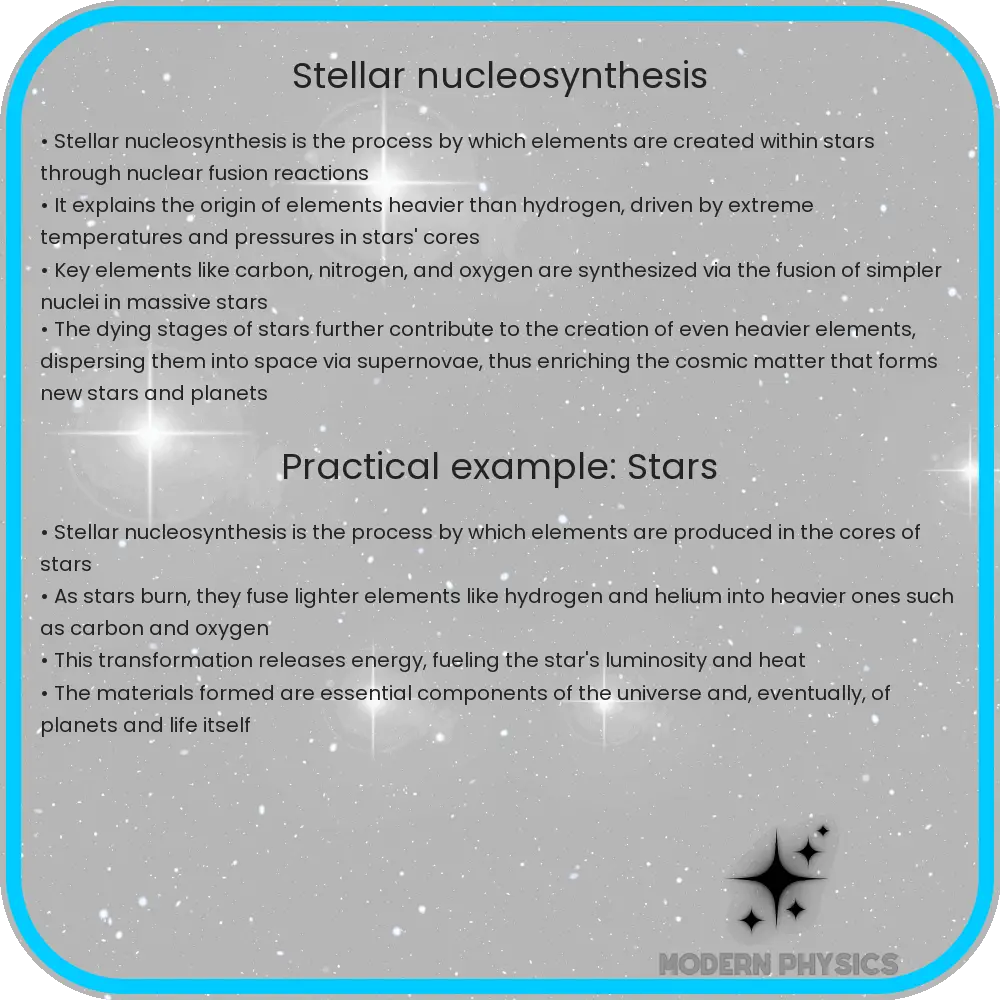Stellar nucleosynthesis is the process of element creation within star cores through nuclear fusion, fueling stars and contributing to cosmic chemical evolution.

Introduction to Stellar Nucleosynthesis
Stellar nucleosynthesis is the process by which elements are created within the cores of stars by nuclear fusion reactions. The nuclei of atoms undergo fusion and produce new and heavier elements, a process that fuels stars and contributes to the chemical evolution of the universe. Understanding this phenomenon not only helps in unraveling the mysteries of stellar life cycles but also in comprehending the origin of elements that make up our world.
How Stellar Nucleosynthesis Occurs
The lifecycle of a star is predominantly spent on the main sequence phase, where it continuously fuses hydrogen into helium, releasing enormous amounts of energy. This process occurs in the core of the star at extremely high temperatures and pressure, facilitating the overcoming of electrostatic repulsion between atoms. As stars evolve, heavier nuclei are synthesized in their cores through a variety of thermonuclear processes.
- Hydrogen Burning: This initial stage involves the fusion of hydrogen nuclei (protons) into helium. The primary pathway for this in most stars is the proton-proton chain reaction, symbolized as:
\[ 4 ^1H → ^4He + 2e^+ + 2\nu_e + energy \]
where \( ^1H \) is hydrogen, \( ^4He \) is helium, \( e^+ \) represents positrons, and \( \nu_e \) are neutrinos. - Helium Burning: As the star exhausts its hydrogen supply, it begins to fuse helium into heavier elements like carbon and oxygen via the triple-alpha process, portrayed by:
\[ 3 ^4He → ^{12}C + energy \]
This stage marks the beginning of the creation of heavier elements in the star. - Advanced Burning Processes: In more massive stars, the fusion continues beyond helium, forming elements up to iron through processes such as carbon burning, neon burning, oxygen burning, and silicon burning. Each of these phases synthesizes new elements up to iron, beyond which energy cannot be obtained via nuclear fusion.
The synthesis of elements heavier than iron requires different astrophysical processes, often involving supernovae, the cataclysmic explosions marking the end of a massive star’s life cycle.
Importance of Stellar Nucleosynthesis
Stellar nucleosynthesis has profound implications, as it is responsible for the creation of the natural elements essential for life. Essentially, all physical matter – from the iron in our blood to the silicon in our electronics – originates from the hearts of stars. This process also influences the heat and luminosity of stars, and hence their habitability. Additionally, the distribution and abundance of elements in the universe can be traced back to patterns of stellar evolution and nucleosynthesis, offering clues about the history and scale of cosmic processes.
Stellar Populations and the Role of Nucleosynthesis
Studies of different stellar populations reveal variations in elemental compositions which provide insights into the nucleosynthesis processes that occurred in previous generations of stars. These stellar populations help astrophysicists understand not only the lifecycle of stars but the evolution of galaxies. For instance, older stars tend to show fewer heavy elements, indicating they were formed before many nucleosynthesis cycles had occurred in the universe.
Challenges in Studying Stellar Nucleosynthesis
While the theory of stellar nucleosynthesis is well-established, studying it presents numerous challenges. Astronomers and astrophysicists rely heavily on observational data collected from telescopes and satellite missions. However, directly observing deep into a star’s core, where these reactions occur, is not possible with current technology. Scientists must instead infer the processes from spectral data and changes in star brightness, among other indirect methods. Additionally, simulating these extreme conditions accurately in laboratories on Earth poses significant technological and budgetary challenges.
Future Directions in Nucleosynthesis Research
Advancements in technology and computational methods hold promise for deepening our understanding of stellar nucleosynthesis. Future telescopes, both ground-based and space-borne, are expected to provide higher resolution data. Moreover, advancements in nuclear physics may lead to better simulations of the conditions found within stars. Researchers are also exploring the implications of stellar nucleosynthesis on astrobiology, pondering how variations in elemental compositions in different star systems might influence the possibility and nature of life.
Conclusion
Stellar nucleosynthesis is a fundamental process that explains the origins and abundances of elements throughout the universe. From fueling the stars to building the very blocks of life, the process of nucleosynthesis touches upon various aspects of astrophysics, chemistry, and even biology. By studying how stars transform lighter elements into heavier ones, we gain insight into the life cycles of stars, the evolution of galaxies, and the overall dynamics of our universe. Despite the challenges in direct observation, continued advancements in technology and science promise to unravel many more secrets of stellar nucleosynthesis, potentially answering some of the most profound questions about the universe and our place within it.
